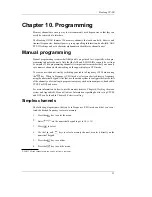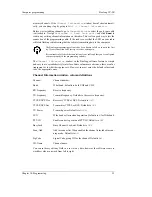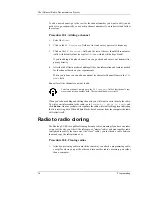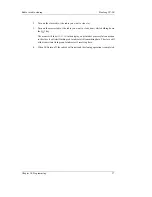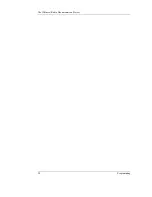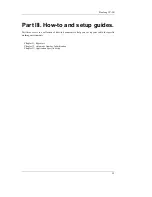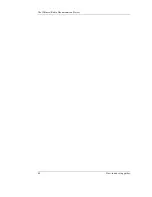
The (Chinese) Radio Documentation Project
46
Application Specific Setup
• Turn DCS and CTCSS off (menu items 10 through 13).
• Turn ANI, DTMFST, S-CODE, PTT-ID off and PTT-LT to 0ms (menu items 15
through 17 and 19 through 20).
• Turn off Squelch Tail Elimination (STE) features (menu items 35 through 37).
• Turn roger beep (ROGER) off (menu item 39).
For further information see Appendix B, Menu definitions and Chapter 4, Working the
menu system.
MilSim: Airsoft and Paintball
If you live in the USA, it is highly recommended that you and your team get yourselves
GMRS licenses to use with your radios. At the time of writing the licensing fee is $85
(per person) and the license is valid for five years. There is no exam involved and any
legal resident of the US over the age of 18 can apply for a license with the FCC using
form 605. Please visit http://fcc.gov/ for more information.
The following is a list of recommended GMRS channels suitable for Airsoft games,
Paintball games, or other recreational military simulations:
462.550 MHz (channel 15)
462.575 MHz (channel 16)
462.600 MHz (channel 17)
462.625 MHz (channel 18)
462.725 MHz (channel 22)
Channel numbers reflect a convention used by Motorola, actual mapping of fre-
quency to channel number may vary between manufacturers.
For those not living in the USA, please contact your local regulatory body in charge of
the radio spectrum to see what your options are.
You may be tempted to use FRS (in the USA) or PMR446 (in Europe) frequencies
while playing. Do note however that there are restrictions on both of these bands
that make this transceiver illegal for use.
Not only do you need a radio with a maximum of 500mW output power (the
Baofeng UV-5R provides at minimum twice that), you also aren't allowed to use
a radio with a detachable antenna or a radio that can be used outside of the FRS
or PMR446 bands.
In the US there is one exception to that rule, and that is FRS+GMRS combo units,
however they are still restricted to 500mW output power on the FRS frequencies,
and they still have to be manufactured with a fixed integral antenna.
Summary of Contents for UV-5R Series
Page 1: ...Baofeng UV 5R The Chinese Radio Documentation Project http radiodoc github com Lennart Lidberg...
Page 6: ...The Chinese Radio Documentation Project vi Baofeng UV 5R...
Page 8: ...The Chinese Radio Documentation Project viii Preface...
Page 10: ...The Chinese Radio Documentation Project 2 Getting started...
Page 24: ...The Chinese Radio Documentation Project 16 Basic Use...
Page 26: ...The Chinese Radio Documentation Project 18 Advanced topics...
Page 34: ...The Chinese Radio Documentation Project 26 DTMF...
Page 38: ...The Chinese Radio Documentation Project 30 Selective calling...
Page 46: ...The Chinese Radio Documentation Project 38 Programming...
Page 48: ...The Chinese Radio Documentation Project 40 How to and setup guides...
Page 56: ...The Chinese Radio Documentation Project 48 Troubleshooting...
Page 68: ...The Chinese Radio Documentation Project 60 Menu definitions...
Page 74: ...The Chinese Radio Documentation Project 66 Colophon...


